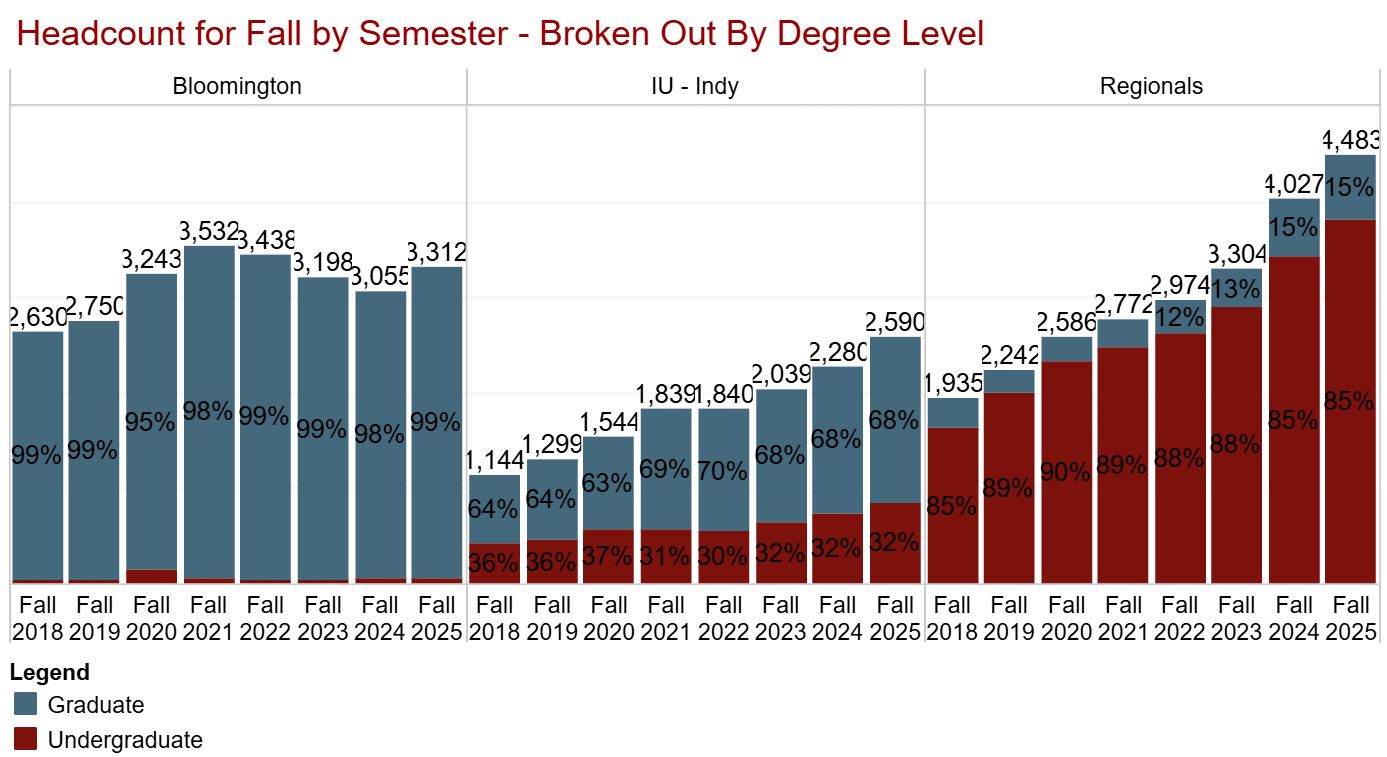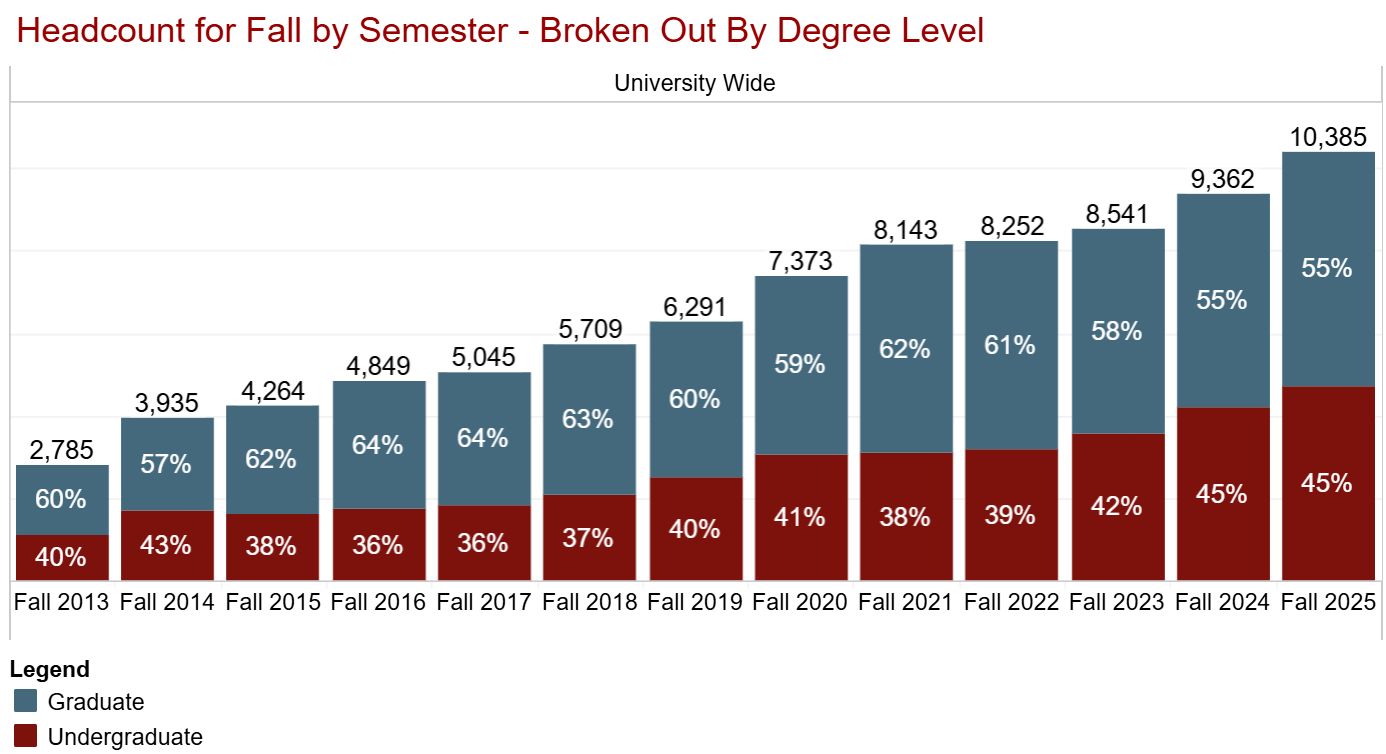The Unsung Builders of Online Learning; IU Online
A centralized coordinating body, aligning and supporting online learning efforts across the Indiana University system

Was this forwarded to you by a friend? Sign up, and get your own copy of the news that matters sent to your inbox every week. Sign up for the On EdTech newsletter. Interested in additional analysis? Upgrade to the On EdTech+ newsletter.
We tend to hear about the same handful of institutions when it comes to online learning: Southern New Hampshire University (SNHU), Western Governors University (WGU), Liberty University (LU), and Arizona State University (ASU). But across the US and around the world, many other universities are steadily building robust online presences. This post kicks off a new series highlighting these less-celebrated institutions, the unsung builders of online learning. Their stories matter because they reveal the many paths institutions can take to build successful, sustainable online operations. They show that context, governance, and mission shape the online enterprise just as much as ambition, funding, or technology. I’m starting with Indiana University Online (IU Online), an organization that has quietly, but deliberately, created one of the more interesting multi-campus online models in the US.
The analysis below draws on interviews and secondary research, including viewing several sessions from the IU Online Conference.
A distinctive university model
IU Online serves as the central organization supporting online learning across Indiana University’s (IU) seven main campuses. Unlike many institutions that have expanded online by establishing separate campuses or new degree-granting entities, IU Online instead operates as a coordinating body, aligning and supporting online learning efforts across the Indiana University system. This isn’t a model often seen outside community college systems. A few university systems have attempted similar approaches, but Indiana is relatively rare in having made it work, and at scale.
IU Online collaborates with all IU campuses to provide academic programs and services that give students a high-quality, interactive, and engaging experience. You can learn more about IU’s collaborative approach to online education in [their foundational documents] “IU Online: A Collaborative Model for Online Education at Indiana University” and “Moving Forward 2.0: IU Online Implementation Plan.”
[snip] IU Online acts as a curricular clearinghouse and provides seamless, shared services for IU’s online students.
IU leaders describe the model as “embedded and collaborative.” It’s embedded because it operates within each of IU’s seven main campuses, and collaborative because those campuses coordinate to avoid duplicating programs and to share faculty expertise. About a quarter of IU Online’s 200-plus programs are delivered collaboratively across multiple campuses, the rest are delivered through a single campus, the rest are cross-campus collaborations. Unsurprisingly, this focus on collaboration and non-duplication is popular with the state legislature, which wants to see efficiencies across the system.
Growth and scale
As of fall 2025, IU Online offered 200+ programs and enrolled more than 10,000 students, just under half of whom were undergraduates. Of late, growth has been brisk: undergraduate headcount rose 12% year over year, and graduate enrollment increased 11%. Fully online students now make up roughly 12% of the IU system’s total headcount.

The makeup of IU Online’s enrollment varies by campus, some enroll more undergraduates, while others are more heavily focused on graduate students. This is evident in comparisons between the Bloomington and Indianapolis campuses and the smaller regional campuses.

IU Online has grown steadily since its launch, but its growth rate has accelerated in recent years.

Themes
In examining IU Online’s growth and future direction, several key themes emerged.
Reach
Like many online initiatives, opening up new pathways for students is a key priority, especially in-state students. While every public university aims to serve its state, online learning changes the stakes: students can enroll anywhere, and national providers such as SNHU, WGU, LU, and ASU actively recruit them. IU Online explicitly seeks to attract Indiana residents who might otherwise go out of state for online programs. Equally important, the online format enables IU Online to serve students where they live across Indiana, expanding options without requiring relocation. As Chris Foley, Associate Vice President, IU Online, often frames it, the goal is to meet Indiana students where they are.
Now we can say that we teach students living in nearly all Indiana counties, and that’s huge.
As a testament to IU Online’s reach within the state, as of 2024 it enrolled more Indiana residents in fully online schedules than even Purdue Global, second only to Ivy Tech Community College in serving Hoosier students.
Faculty focus
A distinguishing feature of IU Online is its strong faculty governance, which can be a plus and a minus. Programs have faculty directors and all collaborative programs are overseen by steering committees with faculty from each campus. IU Online recently created a new Assistant Vice President for Online Academic Programs role to further support that leadership. More than half of all online sections are taught by full-time faculty.
Program innovation and changes
IU Online was announced in fall 2012. Since then, the model has evolved, often in response to periodic reviews conducted every three to four years.
One notable development is the “Programs of Scale” initiative which began under the university’s current president, Pamela Whitten. In the PrOS, a focused portfolio (currently 12) of high-priority programs that receive enhanced instructional-design support, cohesive course design, intensive advising and coaching, and additional marketing. These programs are IU Online’s proving ground for what scalable online growth can look like within a public university system.
A defining feature of these programs is the use of eight-week terms. IU Online now offers a mix of eight-week and traditional fifteen-week courses. Shorter terms are popular with many students for the flexibility they provide; however, some working adults push back because the compression can reduce flexibility in practice. Faculty also note that not every course translates well to an eight-week format. As a result, some programs use eight-week courses for the first two years and fifteen-week semesters for the third and fourth years.
Marketing
A consistent theme in IU Online leaders’ discussions about growth is a clear-eyed view of marketing, its importance, and its cost. On one hand, they lament how hard it is to compete with big brands that spend tens of millions and worry they’re “too Midwestern,” modestly underselling strong programs. On the other hand, they recognize that real growth will require more marketing muscle. It’s a genuine tension.
Student success
An important feature of IU Online is its explicit emphasis on retention and student success, an increasingly common and welcome trend across online programs. Like many, IU Online has struggled to find metrics that fit the online context. Traditional measures built around first-time, full-time students don’t translate when few online learners fit that profile. Instead, IU Online tracks re-enrollment: who was enrolled last term and who re-enrolled this term.
Beyond redefining metrics, IU Online frames student success as a multi-layered funnel: recruiting, a “Go Team” focused on on-boarding and success coaching, program advisors, and a designated liaison to campus financial aid. Downstream, they are beginning to add career services.
The frustration IU Online leaders express about applying traditional metrics online points to a broader need: as a community, we must develop and share approaches tailored to the realities of online learning - its student profiles, pacing, and support requirements.
Organizational structure
IU Online supports its growing portfolio with about 70 FTE in the central office. Over the past year, the unit has centralized additional functions, placing more advising, marketing, and student services in university level offices, especially for undergraduate and collaborative programs, while most other services operate on a hybrid model.
Previously funded by a $30-per-credit distance-education fee, the unit shifted during the pandemic to a revenue-share model: IU Online receives 30% of tuition from asynchronous online programs and 2% from hybrid or on-campus programs.
These funds support four areas:
Compliance, accreditation, licensure, and authorization specific to online education;
Student services and enrollment management for undergraduate and collaborative graduate programs;
Marketing of IU Online programs; and
Program and faculty support (e.g., instructional design and technology, assessment, program management).
The revenue-share arrangement is viewed as a key factor in IU Online’s sustainability, as it’s directly tied to both enrollment and inflation.
Because this revenue system is tied to credit hours, it will provide a sustainable growth for inflation (via tuition increases) and volume (through enrollment increases). It is critical that the budget for online education should be connected to growth in those credit hours in order to adequately scale student services, invest in new technologies, and expand marketing.
IU Online lessons learned, and priorities going forward
Indiana University leaders like to say that, in building IU Online, they learned from others. Its distinctive model aims to avoid the pitfalls it sees, and chart a more successful path. That said, new challenges emerge as the enterprise grows. As Ken Iwama, Vice President for Online and Regional Campuses, noted at the IU Online Conference, Indiana University is a large institution with many voices, and it can be difficult to keep missions aligned across diverse campuses, especially as online learning expands.
Approaches that have sustained growth so far include:
Strong support from upper-level leadership, especially President Pamela Whitten;
Staying adaptive to the university’s evolving needs—today’s model won’t be tomorrow’s;
Embedding online into the curriculum so on-campus students can take courses when needed (on some campuses, this is as high as 75%); and
Setting realistic goals and distinguishing clearly between goals (the what) and strategy (the how), as Vice President Iwama emphasized.
An enrollment number is not a strategy – it’s a goal.
Looking ahead, IU Online plans to improve scalability, especially by managing course production sustainably through what they call “course design maintenance.” The goal is to create durable, well-designed courses that can be reused and updated rather than rebuilt each year, while still preserving meaningful faculty involvement and engagement.
Looking ahead: IU Online’s next challenges
That said, from the outside it’s clear that IU Online will need to grapple with several tough challenges as it moves forward, many of them common across institutions expanding their online footprints.
Scaling while staying faculty-driven - There’s an inherent tension here. As described in the section above, scale usually requires reusing course assets and standardizing templates. Approaches such as these can clash with faculty-centric models. Without finding workable ways to scale, costs and production timelines will rise, slowing growth and undermining IU Online’s success.
Meeting growth goals without overspending on marketing - The university’s latest strategic plan, IU 2030 calls for growing online enrollment.
Increasing online enrollment in academic programs, including career-aligned certificates, and micro-credentials.
Doing so and maintaining current growth rates, let alone increasing them, while keeping marketing costs reasonable will be difficult. This is especially true for microcredentials, where revenue is usually modest but marketing costs often mirror those of more expensive degree programs.
Managing multi-campus collaboration at increasing scale - System-wide collaboration is already complex and will intensify as online permeates more of campus life. I know from having worked for a couple of university systems that resource imbalances, particularly for example from IU Bloomington’s size and research intensity, can create friction. Centralizing more functions (likely necessary as online grows) may further stress campus relationships if not handled carefully.
Responding quickly to shifting demand - IU Online’s collaborative model brings strength, richness, and avoids duplication, but it’s inherently process-heavy. While they have managed this well so far, staying responsive to rapidly changing workforce needs may become more challenging, even with a stated commitment to adaptability and course-correcting when things don’t work.
Parting thoughts
Part of the enduring strength of US higher education is its variety. It follows then that there should be more than one way to grow and sustain online learning. IU Online provides a great example of a different kind of path.
The main On EdTech newsletter is free to share in part or in whole. All we ask is attribution.
Thanks for being a subscriber.

